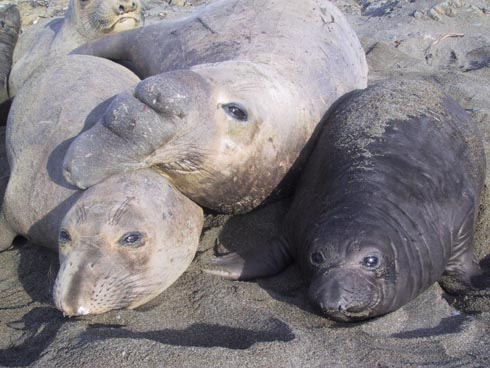San Benito's elephant seal project
The study of male mating tactics is a core aspect of current behavioural ecology and evolutionary biology. In the majority of Mammal species female breeding success is strongly constrained by the investment in gestation and lactation, while males have a marginal role in offspring rearing, and, therefore, are free to put in place a wide array of tactics and strategies to increase access to mates Elephant seals are probably one of the most extreme example of this tendency. Female elephant seals show a main breeding strategy strongly constrained in time and space, produce a single pup per breeding season, and show a modest variation in breeding success among individuals. On the contrary, male elephant seals show a large variation in breeding strategies, may sire hundreds of pups, and their variance in mating success is the highest observed in any animal species. This basic difference in breeding opportunities has deep effect on the whole elephant seal biology, from growth to life history. Moreover, variation in breeding success between males is a main source of phenotypic selection pressures, and, hence, elephant seals are a modal species for the study of sexual selection and evolution of secondary sexual traits. Therefore, elephant seals are an excellent candidate for research on male mating tactics and breeding strategies.

In 2001 we started a research project on the northern elephant seals (M. angustirostris) of the San Benitos Islands (Baja California, Mexico). We observed a very flexible mating system. Although the basic social unit is the harem, i.e., a group of females with a dominant male, the harem holder, peripheral males were able to routinely mate with harem females, and some of them were very successful, having a mating success equal to a harem holders. We also observed a large variation in harem size, female density, number of competitors, topography and micro-climate of the breeding beaches. A preliminary assessment of the data already collected confirmed a more even distribution of copulations than expected, and a large variation among the different harems, breeding beaches, and islands. As a whole, the mating system observed in this population of northern elephant seals seems to be more promiscuous that the mating system observed in the most studied population of the same species, the one of Ano Nuevo (California, USA). Moreover, the distribution of mating success in the San Benitos elephant seals seems to be much less skewed that the distribution observed in a similar population of southern elephant seals. At San Benitos non-holding males are showing various alternative tactics, ranging from permanent residence in the harem as beta males, to control of transit area when females move back and forth from landside harems to water for thermoregulation, to opportunistic pursuit of females leaving harems on their way back to sea. Moreover, also harem holders show a variation of mating tactics, ranging from frequent harem switch, to opportunistic control of wide beaches with scattered females, to regular role change from small harems holding to association to big harems as peripheral.
Male mating tactics are determined by two group of factors: the phenotypic traits of the males who compete for access to females, which, together, are usually called resource holding potential, and the local breeding situation, which constraints the available tactic options. The male phenotype includes structural components (like age or size) and behavioural components (like breeding effort or success in competition with other males). The goal of our research project is to study the interaction between male phenotype and the breeding situation, their effect on mating tactics, and the resulting distribution of breeding success. Although observed mating success is a very good index of real genetic success in some elephant seal populations, there is a widespread evidence that demographic and behavioural measures of breeding success should be validated using molecular methods, due to the presence of alternative mating tactics and sperm competition. Therefore, our research plan includes the following steps: 1) to measure male structural phenotypic traits and behavioural tactics; 2) to collect information on the social and physical environment of the breeding areas; 3) to estimate mating success and genetic paternity; 4) to analyze the variation among breeding areas of the distribution of breeding success, and of the sexual selection pressures acting on male structural phenotype and behavioural tactics. We hope to be able to overcome some of the problems that affected previous studies of mating tactics, like the concentration on one or few social units, that ignores the internal structure of populations or the lack of balance in research effort between the different component of the study, for example between behavioural data and the genetic data.
